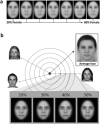The discrimination of facial sex in developmental prosopagnosia
- PMID: 31836836
- PMCID: PMC6910918
- DOI: 10.1038/s41598-019-55569-x
The discrimination of facial sex in developmental prosopagnosia
Abstract
Developmental prosopagnosia (DP) is a neurodevelopmental condition characterised by difficulties recognising and discriminating faces. It is currently unclear whether the perceptual impairments seen in DP are restricted to identity information, or also affect the perception of other facial characteristics. To address this question, we compared the performance of 17 DPs and matched controls on two sensitive sex categorisation tasks. First, in a morph categorisation task, participants made binary decisions about faces drawn from a morph continuum that blended incrementally an average male face and an average female face. We found that judgement precision was significantly lower in the DPs than in the typical controls. Second, we used a sex discrimination task, where female or male facial identities were blended with an androgynous average face. We manipulated the relative weighting of each facial identity and the androgynous average to create four levels of signal strength. We found that DPs were significantly less sensitive than controls at each level of difficulty. Together, these results suggest that the visual processing difficulties in DP extend beyond the extraction of facial identity and affects the extraction of other facial characteristics. Deficits of facial sex categorisation accord with an apperceptive characterisation of DP.
Conflict of interest statement
The authors declare no competing interests.
Figures


Similar articles
-
Impaired perception of facial emotion in developmental prosopagnosia.Cortex. 2016 Aug;81:126-36. doi: 10.1016/j.cortex.2016.04.008. Epub 2016 Apr 21. Cortex. 2016. PMID: 27208814
-
Is developmental prosopagnosia best characterised as an apperceptive or mnemonic condition?Neuropsychologia. 2019 Feb 18;124:285-298. doi: 10.1016/j.neuropsychologia.2018.11.014. Epub 2018 Nov 28. Neuropsychologia. 2019. PMID: 30502377
-
Face identity matching is selectively impaired in developmental prosopagnosia.Cortex. 2017 Apr;89:11-27. doi: 10.1016/j.cortex.2017.01.003. Epub 2017 Jan 11. Cortex. 2017. PMID: 28189665
-
The cognitive and neural basis of developmental prosopagnosia.Q J Exp Psychol (Hove). 2017 Feb;70(2):316-344. doi: 10.1080/17470218.2016.1165263. Epub 2016 Apr 27. Q J Exp Psychol (Hove). 2017. PMID: 26967836 Review.
-
Electrophysiological studies of face processing in developmental prosopagnosia: neuropsychological and neurodevelopmental perspectives.Cogn Neuropsychol. 2012;29(5-6):503-29. doi: 10.1080/02643294.2012.716757. Epub 2012 Oct 16. Cogn Neuropsychol. 2012. PMID: 23066851 Review.
Cited by
-
The Twenty Item Prosopagnosia Index (PI20) provides meaningful evidence of face recognition impairment.R Soc Open Sci. 2021 Nov 3;8(11):202062. doi: 10.1098/rsos.202062. eCollection 2021 Nov. R Soc Open Sci. 2021. PMID: 34737872 Free PMC article.
-
Both identity and non-identity face perception tasks predict developmental prosopagnosia and face recognition ability.Sci Rep. 2024 Mar 19;14(1):6626. doi: 10.1038/s41598-024-57176-x. Sci Rep. 2024. PMID: 38503841 Free PMC article.
-
Why is the literature on first impressions so focused on White faces?R Soc Open Sci. 2021 Sep 22;8(9):211146. doi: 10.1098/rsos.211146. eCollection 2021 Sep. R Soc Open Sci. 2021. PMID: 34567592 Free PMC article. Review.
-
Familial Transmission of Developmental Prosopagnosia: New Case Reports from an Extended Family and Identical Twins.Brain Sci. 2024 Jan 4;14(1):49. doi: 10.3390/brainsci14010049. Brain Sci. 2024. PMID: 38248264 Free PMC article.
-
Face Blindness in Children and Current Interventions.Behav Sci (Basel). 2023 Aug 11;13(8):676. doi: 10.3390/bs13080676. Behav Sci (Basel). 2023. PMID: 37622816 Free PMC article. Review.
References
Publication types
MeSH terms
LinkOut - more resources
Full Text Sources

